Cattle Gate Sizes for Effective Livestock Management

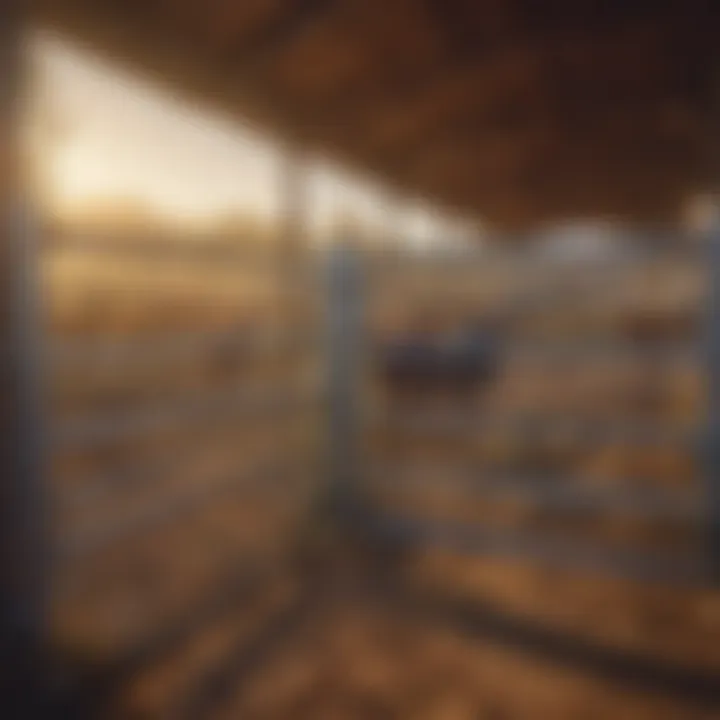
Intro
In agricultural practices, the management of livestock is critical to ensuring a successful operation. Among the many factors that play a role in this management is the size and type of cattle gates. These gates are not mere physical barriers; they are essential tools that facilitate efficient movement of livestock while maintaining safety and control. Understanding the various dimensions and configurations can significantly impact farm efficiency and animal welfare.
Farmers often find themselves at a crossroads when deciding on the appropriate gate sizes. The choice hinges on multiple aspects, such as the breed and number of cattle, the layout of the farm, and specific operational needs. Selecting the wrong gate can lead to unexpected challenges, be it overcrowding in a passage or even injuries among the livestock.
This article dives into the intricacies of cattle gate sizes, reserved for the discerning farmer or agronomist who wishes to optimize their farm management practices. By taking stock of both traditional methods and innovative designs, this piece aims to furnish readers with comprehensive insights into how gate selection intertwines with broader agricultural strategies.
Cattle Gate Basics
Cattle gates play a pivotal role in the realm of livestock management, serving not only as barriers but as essential tools that shape the daily operations on a farm. Their design and functionality facilitate the effective movement of cattle and ensure their safety. Understanding the fundamentals of cattle gates can greatly influence agricultural practices, making it a topic that merits in-depth discussion.
Definition and Purpose
Cattle gates can be broadly defined as barriers installed in pastures or enclosures to control the movement of livestock. Their main purpose is to provide safe access for animals while preventing unauthorized entry or exit. This can encompass a variety of shapes and sizes to cater to the specific requirements of different agricultural setups. A well-designed cattle gate enhances both convenience and safety for the livestock as well as the handlers.
In agricultural contexts, gates often serve additional functions. They help in managing grazing patterns, which can be vital for maintaining optimal pasture health. By strategically placing gates, farmers can guide cattle towards richer grazing areas, effectively optimizing land use and promoting sustainable farming practices.
Because of their importance, it becomes clear that each farm deserves carefully selected gates tailored to its unique operational needs.
Importance in Livestock Management
The importance of cattle gates cannot be overstated when it comes to managing livestock efficiently. They are essential for a variety of reasons:
- Safety: Well-constructed gates help prevent animals from wandering off or mixing with other herds, reducing the risk of accidents and stress.
- Control: Effective gating systems enable farmers to direct cattle movement during feeding, breeding, or health checks—critical times in livestock management.
- Efficiency: Properly sized gates streamline the handling of livestock, allowing for quicker loading and unloading during transport.
- Access: Gates define designated routes for cattle, ensuring that traffic flow on the farm adheres to both safety and efficiency requirements.
Moreover, a well-thought-out gating system can reduce the labor and time required to manage livestock while increasing the overall productivity of the agricultural operation. It is essential for farmers to assess their specific needs and risks associated with cattle management. As such, careful consideration of the type, size, and configuration of cattle gates can yield significant benefits in both daily operations and long-term herd health.
Standard Cattle Gate Sizes
In the realm of livestock management, standard cattle gate sizes hold a pivotal role. These dimensions aren’t just arbitrary figures; they shape the efficiency of daily operations and ensure the safety and well-being of the livestock. Understanding these sizes can aid in preventing injuries, managing movement effectively, and streamlining overall farm operations. The right gate size can make a significant difference in how cattle are controlled and handled, especially in times of transfer or during health checks.
Common Widths
When it comes to cattle gates, width is often the first key dimension to consider. Common widths for gates typically range from 4 to 16 feet. However, most producers find themselves frequently using 8 to 10 feet widths in their operations. This range caters well to average-sized cattle breeds and facilitates efficient access for farm machinery.
Another crucial aspect affecting the choice of width relates to the intended use of the gate. For example, if you frequently need to move larger animals or multiple cattle at once, wider gates are typically necessary. On the contrary, for smaller or more manageable livestock, narrower gates can be sufficient.
"Choosing the right gate size can reduce stress on livestock and increase productivity on the farm."
In considering the operational needs, it’s also wise to think about potential bottlenecks. Minimizing these will enable smoother movement of both cattle and equipment. Therefore, understanding how many animals will move through a gate at any given time can inform the appropriate width needed.
Variations for Different Breeds
Different breeds of cattle exhibit varying sizes, which naturally inflect on the required gate dimensions. For instance, while a herd of Angus cattle might fit comfortably through a standard 10-foot gate, larger breeds like Brahman might necessitate a wider passage due to their bulkier frame.
Moreover, even the behavior of different cattle breeds influences the design choices for gates. Some breeds may exhibit more aggressive tendencies when moving in or out of pens, necessitating additional measures like sturdy latches or higher gates to keep them secure.
The setup of a farm often reflects these differences in breeds; therefore, recognizing how diverse characteristics of cattle affect the need for varying gate sizes is crucial in farm planning. Every choice made can contribute to better overall productivity and safety for both the livestock and the handler.
Factors Influencing Cattle Gate Size Selection
Selecting the appropriate size of cattle gates is crucial for efficient livestock management. The size of a gate can have a significant impact on how smoothly operations run on a farm. Understanding what influences the decision can help farmers optimize their management strategies and ensure the safety and well-being of their cattle.
Type of Cattle
When it comes down to brass tacks, the type of cattle on a farm profoundly influences the required gate size. Different breeds vary in size and behavior, which can affect how much space is needed for them to pass through comfortably.
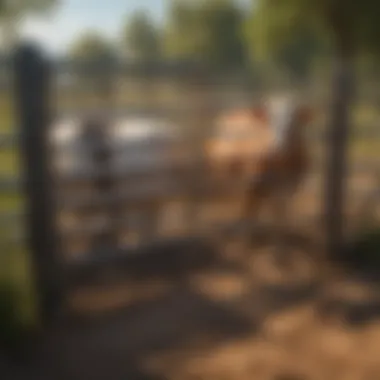
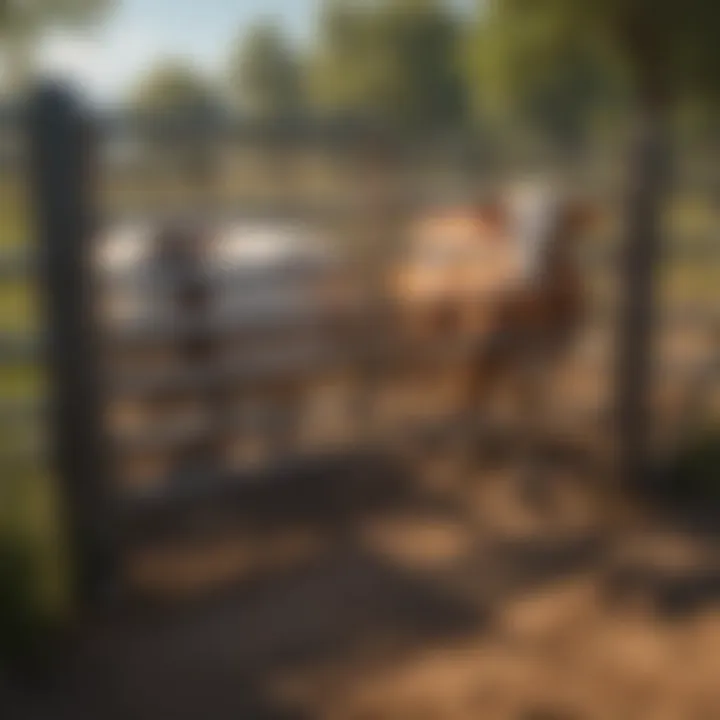
- For instance, larger cattle breeds like Holsteins or Angus may require wider gates to easily move in and out without getting jammed up.
- Conversely, smaller breeds, such as Dexter or miniature cattle, could do just fine with narrower openings.
Apart from size, one must consider the temperamental differences among breeds. If a breed is known for being a bit skittish or aggressive, a farmer might want to opt for gates that provide a little extra room for safe movements. Better to be safe than sorry, as the saying goes.
Farm Layout and Infrastructure
The layout and infrastructure of the farm itself also plays a key role in selecting the right gate size. The overall design of cattle handling facilities, paddocks, and pastures dictates where gates are placed and how big they need to be.
- A farm with a narrow pathway leading to the barn may necessitate slimmer gates to avoid bottleneck situations.
- On the other hand, an open grazing area could benefit from wider gates to facilitate movement, especially when herding.
In addition, considering the setup of other structures such as barns, feeding areas, and water troughs can offer insights into the most practical gate sizes. Sometimes farmers even have to think about existing gates and how new ones can seamlessly integrate into the current setup, as building and redoing infrastructure can be quite costly and time-consuming.
Operational Needs and Access
Another important factor to think about is operational needs and access. This encompasses how often cattle need to be moved, as well as what equipment might be traveling through those gates.
- If regular veterinary checks or movements between pastures are common, larger gates can make the job easier and less stressful for both the cattle and the handlers.
- Furthermore, if machinery like tractors or feed trailers must pass through, gates must be sizeable enough to accommodate this without causing delays.
It all boils down to making life easier for everyone involved. Keeping the flow of daily operations smooth not only saves time but can also enhance overall productivity on the farm.
Regular assessments and adjustments based on these factors can lead to better decision-making.
In summary, thoughtfully considering the type of cattle, the farm layout, and operational needs can greatly impact the effectiveness of cattle management practices. Each of these factors contributes to a well-rounded approach to selecting the right cattle gate sizes.
Innovative Cattle Gate Designs
In the ever-evolving landscape of agricultural practices, innovative cattle gate designs serve as a key player in enhancing operational efficiency and livestock management. Modern technologies and creative designs are now transforming traditional gate systems, making them more adaptable and functional. Farmers and agricultural professionals must embrace these innovations to stay ahead and ensure the wellbeing of their animals while optimizing resources.
Automated Gates
Automated gates have paved the way for impressive advancements in livestock handling without the need for constant manual intervention. These gates operate on various technologies including RFID tags, sensors, and timers, allowing for a seamless interaction between farmers and their cattle. Imagine a setup where cattle can enter and exit pastures without a human needing to swing a heavy gate open. This not only saves time but also reduces physical strain on farmers.
Some benefits of automated gates include:
- Enhanced Monitoring: Automatic systems can be integrated with monitoring software that alerts farmers about cattle activities, making it easier to track their movements and health.
- Increased Safety: With automated access, the risk of injury during manual gate operations diminishes significantly.
- Efficiency Boost: Farmers can multitask more effectively, allowing them to manage other important farm duties while automated systems handle livestock passage.
Moreover, installing an automated gate might require an upfront investment, which can be a concern. However, considering the long-term labor savings and improved animal welfare, it often pays off.
"Automated systems minimize human intervention, leading to better farm productivity and animal care."
Flexible Gate Systems
Flexible gate systems represent another innovative approach, catering to the dynamic needs of livestock management. Unlike traditional gates that are typically fixed in design, these systems allow adjustments to be made according to the situation. This flexibility is particularly useful for operations that handle various breeds or sizes of cattle, or even for farms that experience varying herd sizes across seasons.
Key features of flexible gate systems include:
- Adjustable Widths: Many flexible gates can be resized to accommodate different cattle sizes, ensuring ease of movement for both smaller calves and larger cattle.
- Modular Designs: Some modern gates can be combined with additional panels or sections, adapting to the farm's layout, facilitating changes without needing major overhauls.
- Multi-Functionality: These gates can serve multiple purposes, such as forming temporary enclosures during health checks or breeding, which is essential for effective herd management.
Farmers should carefully consider the specific requirements of their operations when selecting flexible gate systems. A deeper understanding of herd dynamics and land use can lead to more effective use of these innovative designs. By considering both automated and flexible solutions, farmers can tailor their setups to create a responsive environment for their cattle.
Construction Materials and Their Impact on Size Choices
When discussing cattle gates, the materials used in their construction play a pivotal role. The choice between various materials often influences the practicality, cost, and longevity of gates, ultimately affecting livestock management efficiency on the farm. Understanding the implications of these materials helps farmers and agronomists make informed decisions that align with their operational needs and specific conditions of their land.
Wooden vs. Metal Gates
Wood and metal are the two primary materials used for cattle gates, each offering its own set of advantages and drawbacks.
Wooden Gates
Wooden gates are often favored for their aesthetic appeal and ability to blend into a farm's natural surroundings. They provide a rustic charm that many farmers appreciate. However, they require regular maintenance to prevent rotting and damage from pests.
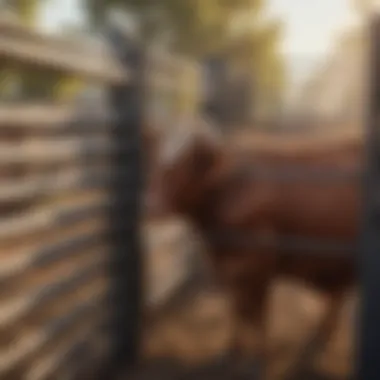
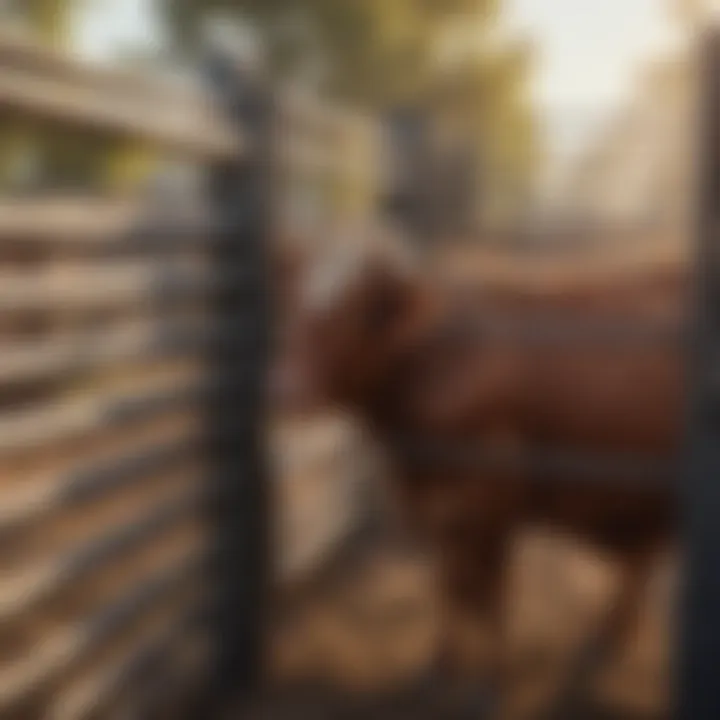
- Pros:
- Cons:
- Attractive appearance contributing to farm aesthetics
- Naturally insulating which can help deter cattle during hot summers
- Prone to weathering and rot over time
- Require paints or treatments for preservation
Metal Gates
On the other hand, metal gates have gained popularity due to their durability and strength. They can withstand more significant impacts from larger cattle and are less likely to succumb to environmental factors. However, they may not blend into the landscape as gracefully as wooden options.
- Pros:
- Cons:
- Extremely durable and resistant to damage
- Generally requires less maintenance than wood
- Can be more expensive upfront
- Might not provide the same level of insulation as wood
Both wooden and metal gates can be designed in various sizes, but the chosen material can limit size options due to strength requirements. A large gate made of wood may require thicker timbers that could become cumbersome, thus affecting usability.
Durability and Maintenance Considerations
The durability of cattle gates directly impacts their size and construction. Durability speaks not just to how long a gate lasts but also its ability to withstand various stresses, environmental conditions, and the cattle themselves.
Regular maintenance is key for any gate, but the type of material can dictate the frequency and type of care needed.
For instance, wooden gates, while beautiful, often need repainting, inspections for rot, and sometimes replacement of boards. This can be a hassle for farmers, especially if they have a larger herd that needs frequent movement. In contrast, metal gates, being sturdier, might just need a quick wash or bolstering of hinges every once in a while.
"A gate that withstands the test of time can be the difference between a well-managed herd and chaos on the farm."
Epilogue
Choosing the right construction material is essential in determining the size and functionality of cattle gates. Both wood and metal offer unique benefits that need to be weighed against considerations like durability and maintenance. As farmers evaluate their needs, understanding the implications of size choices based on material becomes crucial for optimizing their operations.
Regulatory Standards and Compliance for Cattle Gates
Regulatory standards and compliance play a crucial role in the management of cattle gates, influencing not only operational efficiency but also the safety and well-being of livestock. In many agricultural regions, there are specific guidelines that dictate how gates should be constructed, maintained, and deployed. Ignorance of these regulations can lead to costly penalties or, worse, accidents that place both cattle and handlers at risk.
Local Agricultural Regulations
When it comes to cattle gates, local agricultural regulations are paramount for ensuring proper functionality and safety. These regulations often vary by region, taking into account local climates, farming practices, and the types of livestock raised. For instance, a farm in the Midwest that operates primarily with beef cattle might have different requirements compared to a dairy farm in California. Sometimes, these regulations will specify not just the dimensions of gates but also the materials to be used, which ensures durability under specific environmental conditions.
Farmers should conduct regular checks on these regulations because they can change with emerging research and practices.
This does not just protect the cattle but also saves farmers from future liabilities. Building a gate that doesn't meet local specifications may result in reworks, costing time and money. Therefore, establishing solid compliance not only safeguards daily operations but also reinforces a farmer's reputation in the community.
Safety Standards
Equally important are safety standards which ensure that cattle gates prevent accidents and serve their intended purpose without causing injuries to animals or farm workers. These standards cover multiple factors:
- Durability: Cattle are often strong animals, and gates must be sturdy enough to withstand their forces without bending or breaking.
- Accessibility: Gates need to be easy to open and close, especially in emergencies. A stuck gate can lead to chaos if cattle are high-strung.
- Design: Visibility and design also matter. A well-placed gate can prevent entrapment and ensure cattle can see through it, reducing anxiety.
"A safe gate is not just a piece of equipment; it is a vital link in the chain of livestock welfare and operational efficiency."
Farmers should consider training in safe gate use and regular inspections to ensure they meet these required standards. Engaging with agricultural cooperatives or attending local workshops can provide updated insights and resources.
In essence, understanding and adhering to regulatory and safety standards is not merely a bureaucratic exercise. It embodies the foundations of responsible livestock management, fostering an environment where both cattle and farmers can thrive.
Practical Tips for Selecting the Correct Size
Selecting the right size for cattle gates is pivotal in ensuring smooth livestock management and operational efficiency on farms. It’s not just about functionality but also about safety, convenience, and often, compliance with local agricultural guidelines. With so many factors at play, some practical tips can aid in making an informed decision.
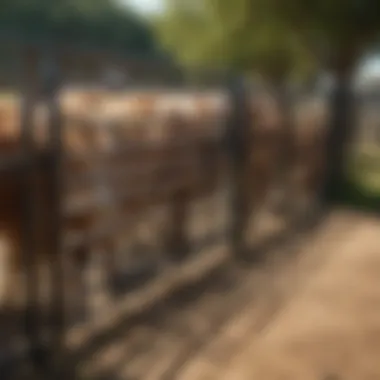
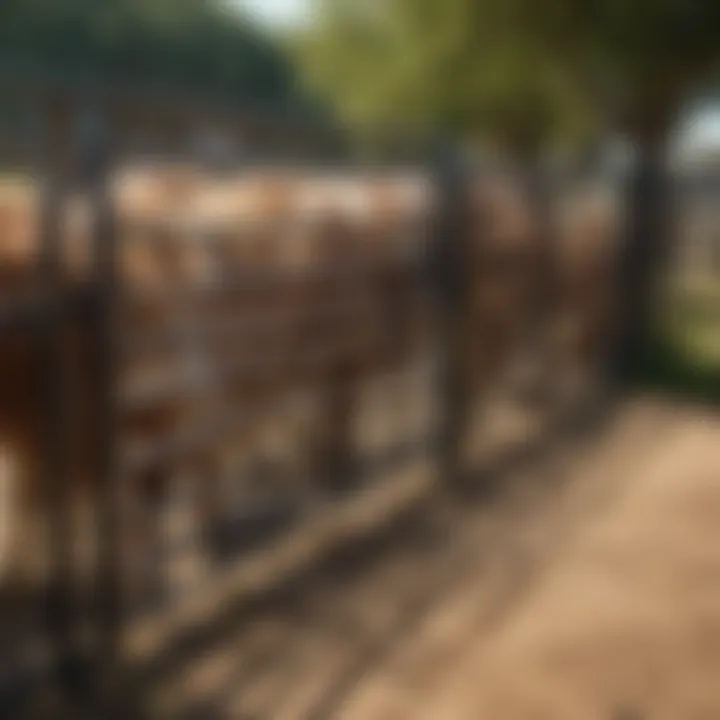
Assessing the Herd
Understanding your herd is a crucial first step in determining the appropriate cattle gate size. The characteristics of the cattle you manage—be it their breed, size, or age—play a significant role in this decision. For instance, Brahman cows are typically larger than Angus, requiring wider gates to avoid crowding or potential injuries.
- Consider Herd Composition: If your farm hosts a mix of breeds, it may be wise to opt for a gate size that accommodates the largest animals to prevent any issues during movement.
- Age Variations: Young calves need smaller areas when entering or exiting pens while adult cattle require more space. Take into account the potential growth of young stock when choosing size.
- Behavioral Traits: Knowing how your cattle behave can also dictate size choice. If they tend to be more skittish and require more space to feel comfortable, wider gates become essential.
Evaluating these aspects will not only determine the size of the gates but also increase herd cohesion and reduce stress during handling, all of which can lead to better productivity on the farm.
Evaluating Farm Infrastructure
Next, take stock of your farm’s infrastructure. This includes the layout, existing fencing, and any other obstacles that might come into play. The chosen size of your cattle gate should mesh seamlessly with these elements.
- Farm Layout: Examine the flow of cattle movement through your farm. If there are narrow paths or tight turns, larger gates may not function as effectively.
- Existing Fencing: Match the gate size with your current fence systems to avoid mismatches that could create vulnerabilities.
- Accessibility Needs: If you expect heavy machinery to pass through the gates frequently, ensure there's ample clearance. It’s smarter to choose a size that accommodates both livestock and farm equipment to enhance workflow.
- Future Constructions: If you plan on expanding or altering parts of your farm, consider opting for slightly larger gates to facilitate potential changes down the line.
Adapting your cattle gate choices to fit within the broader context of your infrastructure helps in creating a smoother operational dynamic and enhances overall management efficacy.
"A well-chosen gate not only facilitates cattle movement but also minimizes stress for both animals and handlers, fostering a productive environment on the farm."
In summary, thoughtful assessment and evaluation of herd characteristics and existing infrastructure can guide farmers in making the right choices regarding cattle gate sizes. The implications extend beyond mere aesthetics – they touch on operational efficiency, animal welfare, and long-term sustainability on the farm.
Future Trends in Cattle Gate Development
The landscape of cattle management is ever-evolving, with new trends reshaping the way farmers approach gate design and functionality. Staying ahead of the curve in cattle gate development is not just a matter of convenience; it directly impacts efficiency, animal welfare, and farm productivity. Understanding these trends is paramount for those in agriculture, as they can offer solutions tailored to modern agricultural practices.
Advancements in Technology
As technology continues embarking into various sectors, cattle management is not left in the dust. The integration of smart technology into cattle gates heralds a new era of functionality. Automated gates, equipped with sensors and operated through mobile apps, allow farmers to control access remotely. Imagine running your farm operations from the convenience of your pocket! They can open or close based on pre-set conditions, such as the time of day or the proximity of cattle.
Moreover, advancements in materials are also shaping the gates themselves. With the development of lightweight yet durable composites, cattle gates can be made larger without becoming cumbersome. This also leads to longer-lasting structures with reduced maintenance needs. In essence, these technological innovations provide greater flexibility, making it easier to adapt settings to the specific needs of different breeds or farm layouts.
"Incorporating technology into cattle management can save time, reduce labor costs, and even enhance the overall health of the herd."
Sustainable Practices in Gate Design
In the present age, sustainability isn’t just a buzzword; it’s a necessity. Cattle gate design is now being influenced by eco-friendly practices more than ever. Farmers are increasingly leaning towards materials that are both environmentally friendly and economically viable. For example, using recycled metals or sustainably sourced wood plays a crucial role in minimizing the carbon footprint of farm operations.
Also, the layout and size of the gates are being re-evaluated to ensure that they facilitate better grazing patterns and herd movement. Ensuring cattle have ample access to fields while limiting overgrazing can be achieved with thoughtful gate placements and designs.
Additionally, solar-powered gates are making waves in the agricultural community. These installations not only provide energy efficiency but also reduce reliance on traditional power sources, leading to lower operational costs over time. In a world increasingly focused on climate change, practices that prioritize sustainability are becoming essential.
The trends in cattle gate development reflect our commitment to adapting agricultural practices in line with the needs of modern farming. As technology advances and the push for sustainable practices intensifies, understanding these trends will enable farmers to optimize their operations while ensuring the well-being of their livestock.
Closure
In the realm of livestock management, understanding cattle gate sizes is not merely a matter of convenience—it's essential for operational efficiency and animal welfare. Cattle gates act as gateways, both literally and figuratively, to the smooth flow of farm activities. When you make an informed choice about gate sizes, it weaves together several critical elements, such as herd safety, ease of movement, and infrastructure compatibility.
A well-chosen cattle gate minimizes stress for both animals and handlers. The right width prevents crowding and allows cattle to pass without getting agitated, ultimately enhancing their health and productivity. Furthermore, proper sizing can alleviate pressure on farm infrastructure, reducing wear and tear on both gates and surrounding areas.
In this article, we've delved into numerous aspects that help illuminate the nuances of cattle gate sizes—from standard dimensions to specific considerations influenced by types of cattle and farm layouts. Each point woven into this narrative contributes to a larger understanding of the relationship between gate design and overall farm function. The significance of this cannot be overstated; overlooking gate dimensions can result in inefficiencies that ripple through the entire operation.
Recap of Key Points
- Standard Sizes: Common gate widths range to suit different livestock breeds and farm needs, with 12 to 16 feet often being a safe bet for standard cattle.
- Calculation Factors: Various factors influence gate selection including the type of cattle, farm layout, and specific operational needs.
- Material Choices: The construction material, whether wood or metal, plays a role not just in durability but also dictates the dimensions of the gate.
- Future Trends: Innovations like automated and flexible gate systems are revolutionizing how livestock handlers interact with equipment.
"Choosing the correct size is like laying the foundation of your farm; it supports everything else that builds on top of it."
Encouragement for Informed Decision Making
Given the wide array of factors at play, encouraging informed decision-making when selecting cattle gates is crucial. Engaging with reliable sources, whether industry experts or reputable agricultural websites, can clarify the various requirements that come with different gate sizes.
Farmers should consider not just immediate needs but also long-term implications. As agricultural practices evolve, embracing sustainable designs and emerging technologies will also influence future gate selections. Thus, a mindset oriented towards continual improvement will serve stakeholders well.
Take time to analyze your herd's behavior, assess your infrastructure, and anticipate operational changes on the horizon. Sometimes, a mere tweak in size or style can lead to enhanced productivity and improved management practices. How in-depth you go into this analysis may well determine your farm's success.
In summary, understanding cattle gate sizes isn’t just about choosing a barrier; it is about fostering an environment where both livestock and farmers can thrive.



